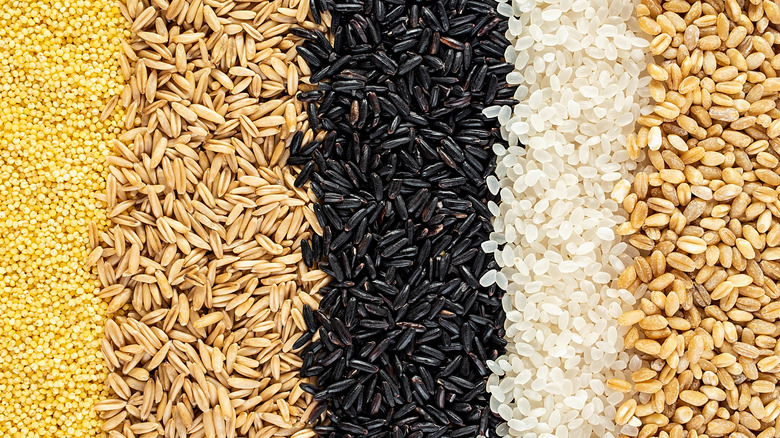Why You Should Always Read The Label When Buying Grains
There's a good reason why you should always keep barley in your pantry. According to Science, grains and cereals have been an essential part of the human diet for a long time, possibly 100,000 years. In fact, National Geographic reports that we get about 48% of our calories from these shelf-stable foods. Who doesn't love a bowl of cereal, a slice of toast, sushi made with your favorite short-grain white rice, and pasta dishes too many to name? Grains are carbohydrate-rich, and they are delicious.
According to Food Insight, corn, wheat, and rice are three of the most popular grains we nosh on, representing 51% of calories eaten across the globe. The site explains that grains are classified into three varieties: whole, refined, and enriched. Of the three, homemade whole grain foods like brown rice, quinoa, and oats, are touted as being the most nutrient-rich. The Mayo Clinic concurs and notes whole grains are full of fiber which keeps your appetite in check and eating them may help lower the risk of a laundry list of diseases. But if you jump on this bandwagon, you should always read the labels before buying your grains, and here's why.
Look out for whole grains
According to the blog My Fitness Pal, if it doesn't say "100% whole grains" on the packaging and nutrient label, you may want to set the package down and keep looking. Food Insight explains that whole grains are the entire grain, which includes the bran, the germ, and the endosperm. Each part of the grain contains nutrients like B vitamins, fats, minerals, and starches, so when you eat whole grain, you get all that goodness.
The Washington Post explains that this is particularly true with a grain like barley because barley's hull is not something you can consume, so you would want to look for a label that contains words like "hull-less" or "hulled" barley if you want the whole grain variety. Additionally, per the Whole Grains Council, you may want to look for packaging with a "Whole Grain Stamp." This stamp assures consumers the food they are eating has a complete serving of whole grains. However, the stamp is still catching on, so the Council recommends being a little leery when you see the words "whole grain" but nothing else. The site uses "whole grain crackers" as an example of food you may want to reconsider because it likely doesn't contain a vast amount of this ingredient.

